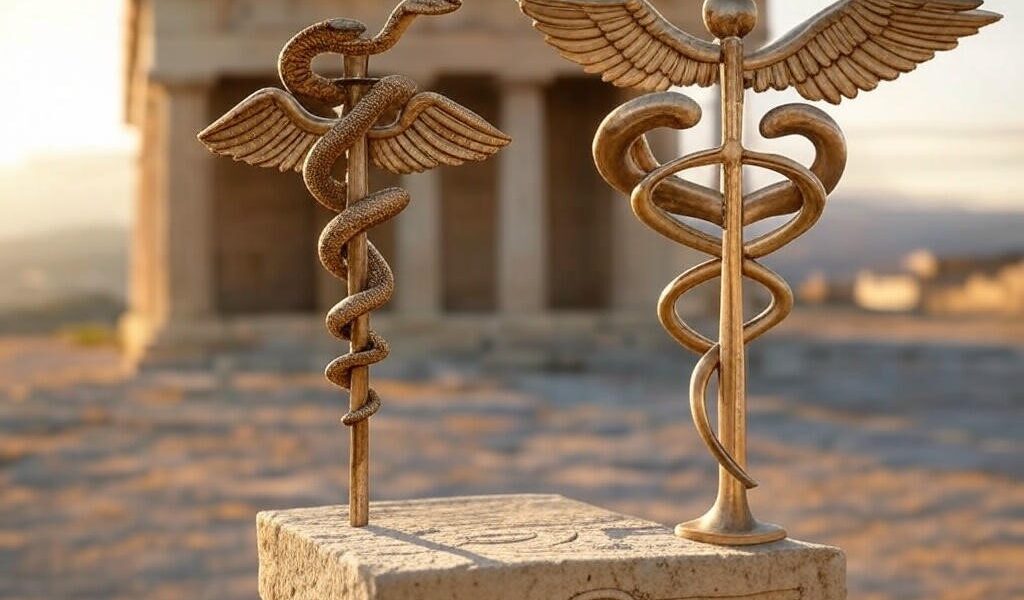Key Points
- Research highlights the Rod of Asclepius, a staff entwined with a single snake, as a timeless symbol of medicine, prominently featured in logos like the World Health Organization’s.
- Its origins likely stem from Greek mythology, tied to Asclepius, the god of healing, with possible influences from ancient medical practices such as treating parasitic worms.
- Evidence suggests the snake embodies rebirth and the dual essence of medicine—balancing life and death—though interpretations differ.
- Controversy arises from its frequent confusion with the caduceus, a two-snake, winged staff linked to commerce, not healing.
What is the Rod of Asclepius?
The Rod of Asclepius is a striking emblem: a simple staff with a lone snake coiled around it, universally acknowledged as a symbol of medicine and healing. You’ll spot it in the logos of major health organizations, including the World Health Organization. Yet, it’s often mistaken for the caduceus—a staff with two snakes and wings—tied to Hermes and commerce, not medicine. This symbol carries a deep cultural resonance for Greeks, rooted in our ancient heritage.

A Mythological Journey: Asclepius and His Legacy
In Greek mythology, Asclepius, the son of Apollo and the mortal Coronis, emerges as the divine healer. After Apollo punished Coronis for her infidelity, he rescued their unborn child from her womb. Raised by the wise centaur Chiron, Asclepius mastered the art of healing, even learning to bring the dead back to life. This extraordinary gift unsettled Zeus, who feared mortals might rival the gods’ immortality. With a thunderbolt, Zeus ends Asclepius’ mortal life, but his story doesn’t end there—he ascended as a god (Ancient Origins).
Asclepius’ cult spread across ancient Greece, giving rise to the Asclepieia—sacred healing temples. Here, the sick would sleep, hoping for divine dreams revealing cures, a practice that echoes modern hospitals. These sanctuaries, often home to the non-venomous Aesculapian snakes named after him, became beacons of hope and healing.
Origins and Symbolism: A Greek Legacy
The Rod of Asclepius’s roots may stretch beyond Greece. One theory ties it to ancient Egypt, around 1500 BC, where physicians treated guinea worms by winding them around sticks—a striking parallel to the symbol (Symbols Archive). Another links it to the Biblical tale of Moses, whose bronze serpent on a pole healed snakebites, suggesting a broader cultural exchange (Britannica).
In Greek tradition, the snake symbolizes renewal through its skin-shedding, mirroring the healing process. It also reflects medicine’s dual nature: venom can kill, yet it heals, embodying the balance of life and death. For ancient Greeks, snakes were guardians of wisdom, making them a fitting emblem for Asclepius, the healer god.
The Caduceus Confusion
Despite its ties to medicine, the Rod of Asclepius is often overshadowed by the caduceus, Hermes’ staff with two snakes and wings. While the caduceus reigns in commercial contexts—especially in the U.S., where 76% of such organizations use it—62% of professional medical groups, like the British Medical Association, stay true to the Rod of Asclepius (Eye). For Greeks, this distinction matters, preserving the authenticity of our medical heritage.
A Symbol Enduring Time
Today, the Rod of Asclepius stands tall in global healthcare, from pharmacies to the World Health Organization. It’s a nod to Greece’s ancient medical contributions, echoed in the Hippocratic Oath, where new doctors swear by Apollo, Asclepius, and his daughters Hygieia and Panacea (Wikipedia). Once slithering through Asclepieia, the Aesculapian snakes add a tangible link to this legacy, their presence believed to aid healing.
Why It Matters to Greeks
For those of us tied to Greek culture, the Rod of Asclepius is more than a symbol—it’s a bridge to our past. It connects the mythological might of Asclepius to the practical wisdom of the Asclepieia, showcasing Greece’s foundational role in medicine. As the world embraces this emblem, it’s a proud reminder of our enduring influence.
Conclusion
The Rod of Asclepius weaves mythology, history, and symbolism into a powerful emblem of healing. From Greek origins to modern global presence, it encapsulates medicine’s eternal dance with life and death. For a Greek audience, it’s a call to honor our ancestors’ wisdom—a legacy that continues to shape the world.

